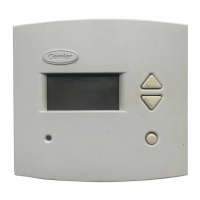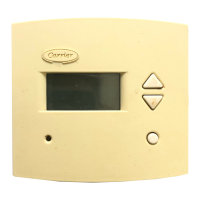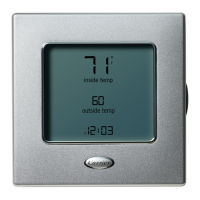CONTINUOUSLY RESETTING DISPLAY — If the by-
pass controller display continuously resets (zeros rotate), it
is an indication that the bypass controller is continuously go-
ing through the power-up sequence and cannot proceed into
its normal operating mode.
Check for any of the following conditions that would cause
the display to blink or constantly display 4 zeros:
• Low voltage from the 24 vac/20 va (25 va for pressure
sensor) transformer. Acceptable voltage range is 21 to
30 vac.
• Unsteady 10 vdc across the red and white wires from the
damper board to the bypass controller.
• The yellow or blue wire from the damper actuator to the
bypass controller wiring connector board is broken or dis-
connected. Try a different bypass controller to see if the
same problem occurs.
• The bypass controller ribbon cable is improperly installed
or defective. See Fig. 12 for troubleshooting information.
• The bypass controller wiring connector board is defective.
• The bypass controller or damper actuator is defective.
Bypass Controller Communication Problems —
Most communication problems are associated with im-
proper configuration of the system devices, faulty wiring, or
a failure of a single device connected to the communication
bus. The following is a brief communication bus trouble-
shooting procedure.
If one or more devices are experiencing any of the fol-
lowing communication problems perform the troubleshoot-
ing procedure below:
• The bypass controller or zone controller does not cor-
rectly indicate equipment fan operation or the current sys-
tem mode.
• During the Communication Check, the monitor thermo-
stat of the bypass controller fails to verify communica-
tions with the bypass controller.
NOTE: The nature of the communication bus is such that
one item can cause multiple problems or one error can cover
up several problems. If a problem is found, correct it and
check the communication bus for other communication prob-
lems that may appear.
1. Check the device address of the bypass controller. If the
bypass controller is configured to communicate in a VVT
system, it must be addressed within the scanning range of
its monitor thermostat. Check the device bus configura-
tion and make sure the bypass controller is on the same
bus as the monitor thermostat.
2. Check the configuration of the communication related op-
tions of the monitor thermostat and each device in the
VVT system. Each device has one or more communica-
tion related options that could be misconfigured.
3. Check the mounting and cover plates of the bypass
controller for protruding screw heads or bent interior
standoffs.
Protruding screw heads on the rear mounting plate can
cause a short between the rear pins of the set point but-
tons. The bypass controller cannot communicate with the
monitor thermostat when its set point buttons are
depressed. Bent interior standoffs can be constantly de-
pressing the set point buttons and prevent the device from
communicating.
4. Check the bypass controller wiring connector board for
the correct communication bus wire connections. The red,
green, and black wires must be in their proper locations.
The wiring connector board is labeled to indicate the cor-
rect wiring connections. See Fig. 12 and check for a faulty
ribbon cable, wiring connector board or failed TVA(Tran-
sient Voltage Arrestor).
5. Check the communication bus voltages. Check the volt-
age between the green and red and the black and green
wires. There should never be any AC voltage measured
on the communication bus. AC voltage of any level can
cause communication problems. If AC voltage is mea-
sured, the source must be located and removed.
On the communication bus, the following voltages should
be measured: red to green 3.1 to 3.6 vdc, black to green
1.4 to 1.9 vdc. If the correct voltage is not measured, the
communication bus may have a device with weak I/O driver
or faulty wiring connections.
If the communication problem still exists, a device on the
communication bus could be defective or the communica-
tion bus wiring may be faulty.
21

